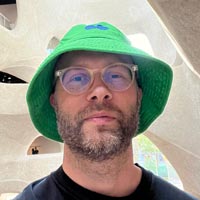Lifelike movement
 By Robin Dowling · 5 months ago
By Robin Dowling · 5 months ago
In the evolution simulation, groups of organisms often move together—shifting, splitting, and reforming in fluid patterns that resemble bird murmurations. There’s no leader, no shared objective, and no explicit rule to move as a group. Yet the behavior emerges naturally from decisions made by each individual.
Each organism evaluates its surroundings and decides whether to move based on its current individual needs: eating, reproducing, fleeing danger, or just exploring. If it’s low on energy and remembers a location where energy was once found, it moves in that direction. If it’s looking for a mate, it looks for nearby compatible organisms or moves toward places where it has seen others of its kind.
Organisms also prefer to stay close to others of their own species—especially when resting or reproducing—so they tend to cluster. But occasionally, one ventures off. If that organism finds something valuable, others nearby might gradually follow, drawn by the same logic, not by any awareness of the movement as a group.
What emerges is lifelike: organisms migrating across the world, forming temporary herds or colonies, and collectively shifting direction without coordination. The group behavior is entirely emergent, built from individual logic and memory—no central control, no global plan.